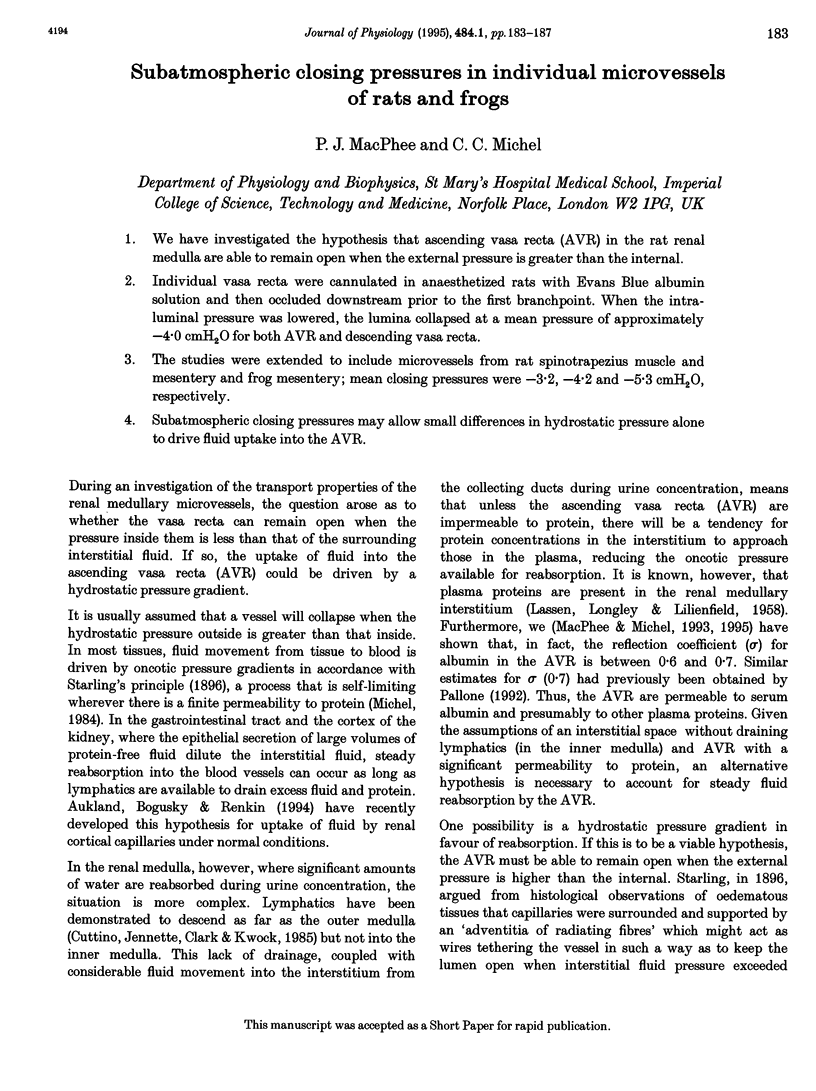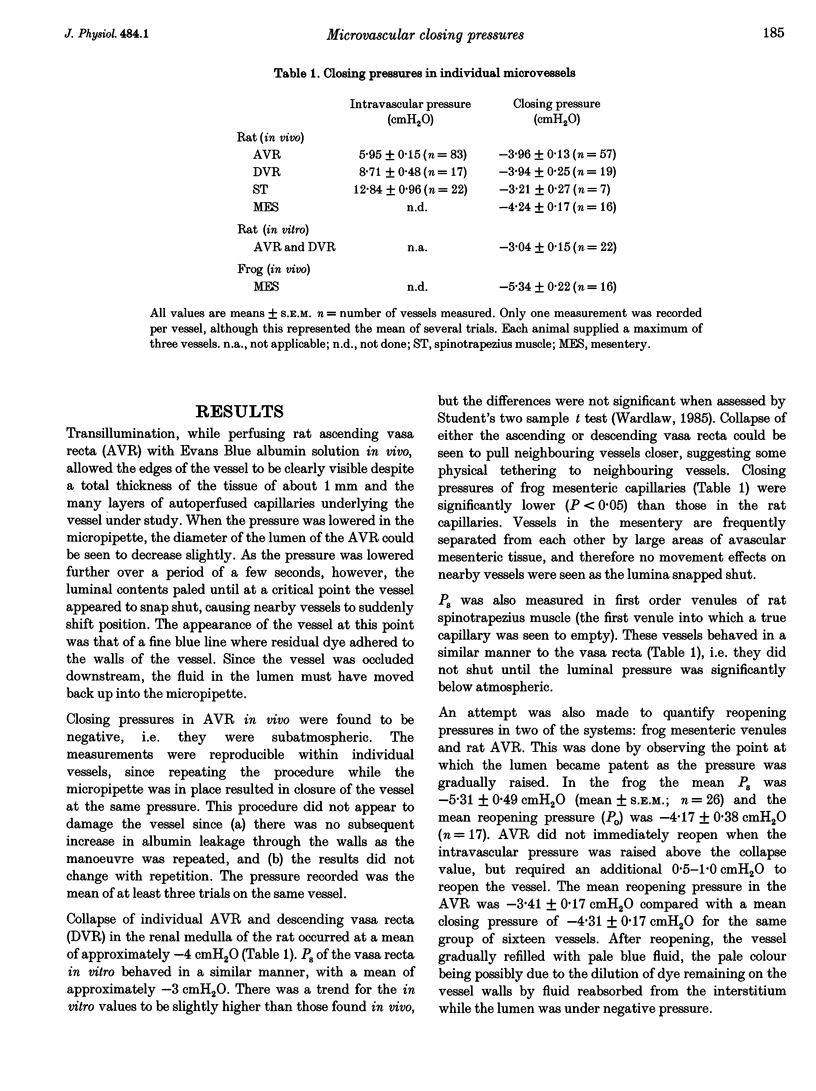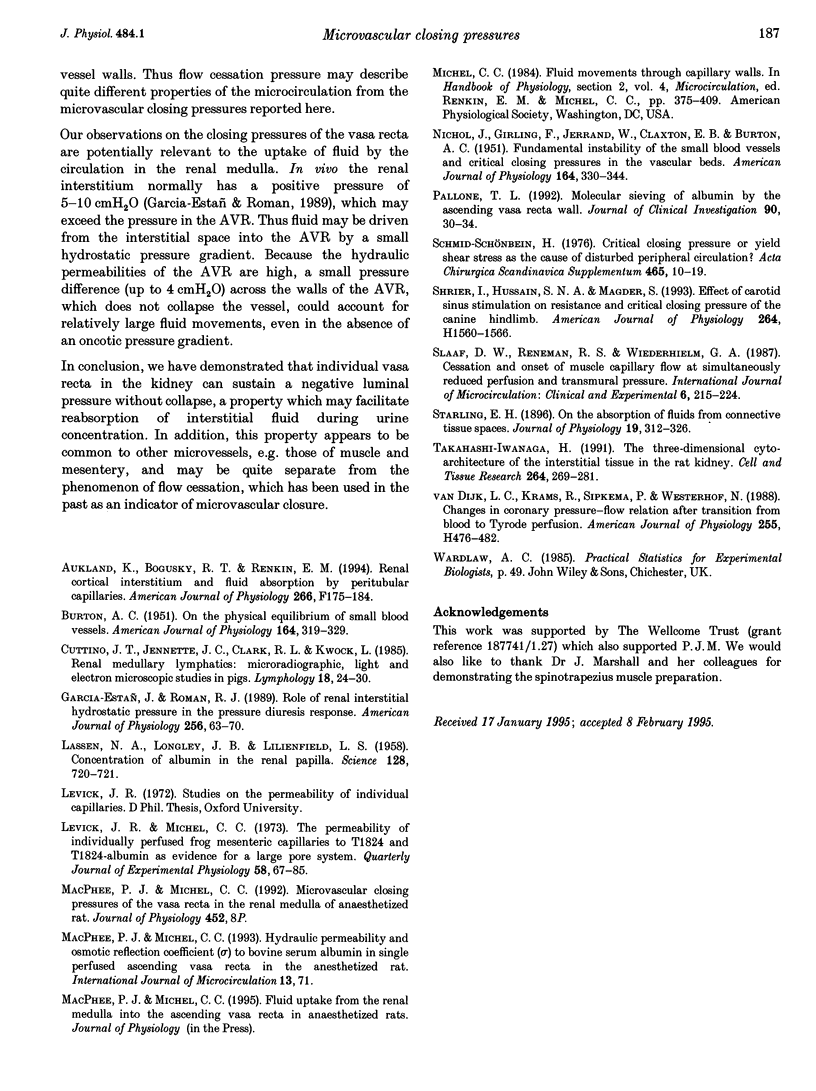Abstract
1. We have investigated the hypothesis that ascending vasa recta (AVR) in the rat renal medulla are able to remain open when the external pressure is greater than the internal. 2. Individual vasa recta were cannulated in anaesthetized rats with Evans Blue albumin solution and then occluded downstream prior to the first branchpoint. When the intraluminal pressure was lowered, the lumina collapsed at a mean pressure of approximately -4.0 cmH2O for both AVR and descending vasa recta. 3. The studies were extended to include microvessels from rat spinotrapezius muscle and mesentery and frog mesentery; mean closing pressures were -3.2, -4.2 and -5.3 cmH2O, respectively. 4. Subatmospheric closing pressures may allow small differences in hydrostatic pressure alone to drive fluid uptake into the AVR.
Full text
PDF




Selected References
These references are in PubMed. This may not be the complete list of references from this article.
- Aukland K., Bogusky R. T., Renkin E. M. Renal cortical interstitium and fluid absorption by peritubular capillaries. Am J Physiol. 1994 Feb;266(2 Pt 2):F175–F184. doi: 10.1152/ajprenal.1994.266.2.F175. [DOI] [PubMed] [Google Scholar]
- BURTON A. C. On the physical equilibrium of small blood vessels. Am J Physiol. 1951 Feb;164(2):319–329. doi: 10.1152/ajplegacy.1951.164.2.319. [DOI] [PubMed] [Google Scholar]
- Cuttino J. T., Jr, Jennette J. C., Clark R. L., Kwock L. Renal medullary lymphatics: microradiographic, light, and electron microscopic studies in pigs. Lymphology. 1985 Mar;18(1):24–30. [PubMed] [Google Scholar]
- LASSEN N. A., LONGLEY J. B., LILIENFIELD L. S. Concentration of albumin in renal papilla. Science. 1958 Sep 26;128(3326):720–721. doi: 10.1126/science.128.3326.720. [DOI] [PubMed] [Google Scholar]
- Levick J. R., Michel C. C. The permeability of individually perfused frog mesenteric capillaries to T1824 and T1824-albumin as evidence for a large pore system. Q J Exp Physiol Cogn Med Sci. 1973 Jan;58(1):67–85. doi: 10.1113/expphysiol.1973.sp002192. [DOI] [PubMed] [Google Scholar]
- NICHOL J., GIRLING F., JERRARD W., CLAXTON E. B., BURTON A. C. Fundamental instability of the small blood vessels and critical closing pressures in vascular beds. Am J Physiol. 1951 Feb;164(2):330–344. doi: 10.1152/ajplegacy.1951.164.2.330. [DOI] [PubMed] [Google Scholar]
- Pallone T. L. Molecular sieving of albumin by the ascending vasa recta wall. J Clin Invest. 1992 Jul;90(1):30–34. doi: 10.1172/JCI115852. [DOI] [PMC free article] [PubMed] [Google Scholar]
- Schmid-Schönbein H. Critical closing pressure or yield shear stress as the cause of disturbed peripheral circulation? Acta Chir Scand Suppl. 1976;465:10–19. [PubMed] [Google Scholar]
- Shrier I., Hussain S. N., Magder S. Effect of carotid sinus stimulation on resistance and critical closing pressure of the canine hindlimb. Am J Physiol. 1993 May;264(5 Pt 2):H1560–H1566. doi: 10.1152/ajpheart.1993.264.5.H1560. [DOI] [PubMed] [Google Scholar]
- Slaaf D. W., Reneman R. S., Wiederhielm C. A. Cessation and onset of muscle capillary flow at simultaneously reduced perfusion and transmural pressure. Int J Microcirc Clin Exp. 1987 Aug;6(3):215–224. [PubMed] [Google Scholar]
- Starling E. H. On the Absorption of Fluids from the Connective Tissue Spaces. J Physiol. 1896 May 5;19(4):312–326. doi: 10.1113/jphysiol.1896.sp000596. [DOI] [PMC free article] [PubMed] [Google Scholar]
- Takahashi-Iwanaga H. The three-dimensional cytoarchitecture of the interstitial tissue in the rat kidney. Cell Tissue Res. 1991 May;264(2):269–281. doi: 10.1007/BF00313964. [DOI] [PubMed] [Google Scholar]
- Van Dijk L. C., Krams R., Sipkema P., Westerhof N. Changes in coronary pressure-flow relation after transition from blood to Tyrode perfusion. Am J Physiol. 1988 Sep;255(3 Pt 2):H476–H482. doi: 10.1152/ajpheart.1988.255.3.H476. [DOI] [PubMed] [Google Scholar]


